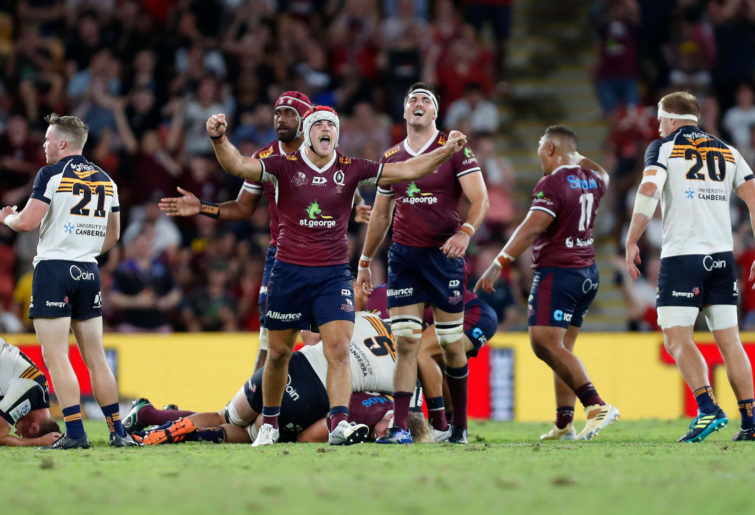
So, it turns out that Fraser McReight can pass from left to right, which is good because he couldn’t reliably do so at the beginning of last year and it had cost the Queensland Reds likely tries on a couple of occasions.
That bit of newly improved skilled was buried in an excellent performance from the Queensland Reds, in their 29-16 win over the Western Force in Perth on Friday night.
As you can see from the 0:20 mark on the highlights reel, McReight’s pass was critical in linking James O’Connor’s straightening of the attack and pass to McReight for a break down the left-hand try line.
McReight’s pass found Hamish Stewart who had worked very hard off the ball to get from outside and behind McReight and put himself into the position inside to score the opening try of the match.
The try highlights how the Reds are turning around a major problem in Australian grassroots rugby coaching, as identified by former Wallabies captain Phil Kearns, after the 2019 World Cup loss. Kearns’ truth bomb went like this: “Our coaching for the last 15-20 years has been terrible, not just at Wallaby level, I’m talking about juniors and the skills that we teach them, the way we ask them to play the game.
“We teach this shape and pattern and structure and process which is all rubbish. because if you can’t catch and pass and kick and tackle, you can’t play the game.”
So, for the Reds to be taking the lead on skills is fantastic. The example can only be filtering down into Queensland clubs and schools, and through heightened competition across the country.

(Photo by Regi Varghese/Getty Images)
The only observation that I would make about the Stewart try is that it was against a fairly passive Force defence, with their coach Tim Samson citing lack of line speed as a problem.
O’Connor appeared to hesitate and roll back on his heels as he waited for halfback Kalani Thomas to pass. I am not a professional 10 or an attack coach, so I can only ask the question: does this indicate that there is some work to do in terms of O’Connor trusting his halfbacks to deliver if he runs hard onto the ball?
Would it be a problem against a more well-drilled defence?
We are likely to find out in weeks to come, but I am sure that O’Connor, who is an incredibly committed professional, will go over every aspect of his game this season to eke out every possible advantage.
The other improvement the Reds demonstrated was the work they had done on improving player strength during the long off-season, which they have spoken of on a number of occasions.
In social media posts, co-captain Liam Wright in particular looked like he had added an impressive amount of muscle, though he was out with injury for this game.
The results of this work were on show at the breakdown, with the Reds delivering quick ball through one-player cleanouts, leaving the remaining 13 players available to attack.
A great example of this starts at 4:43 on the highlights reel with Reds fullback Jock Campbell cleaning out Force inside centre Richard Kahui, after a bustling run by Taniela Tupou.
Kahui is listed online as being 14 kilograms heavier than Campbell and as a former All Black has elite breakdown expertise, so Campbell’s effort to quickly clean him out and facilitate a spectacular aerial over-the-sideline try by winger Reds Josh Flook was a commendable demonstration of power.
Join experts Brett McKay and Harry Jones and special guest Jamie Wall as they look at Super Rugby week 2, that debut by Roger Tuivasa-Sheck and tip what four teams will miss the finals this year.
The Reds’ defence also appeared to benefit from the strength work, with the Force making an average of three metres per run compared to the Reds’ four metres, despite the Force making five clean breaks to four.
Superior breakdown and defence work manifested with the Reds dominating possession 55 per cent to 45 per cent, and 58 per cent territory to 42 per cent.
This was despite comparable performances at the set piece, the Reds being down to 14 players for 20 minutes due to yellow cards and losing their best lock and game day captain, Lukhan Salakaia-Loto, after five minutes.
The improvements across the entire Reds squad are fantastic, though there is still more work to be done, notably in patience and discipline from a number of players.
Not to discount the Fijian Drua, but we will see how these benefits play out against the Reds’ arch rivals the Brumbies in a couple of weeks’ time and against the New Zealand sides over the next couple of months.
In the meantime, these men can be proud of the standard they are setting to all Australian rugby players, with their commitment to constant individual improvement.